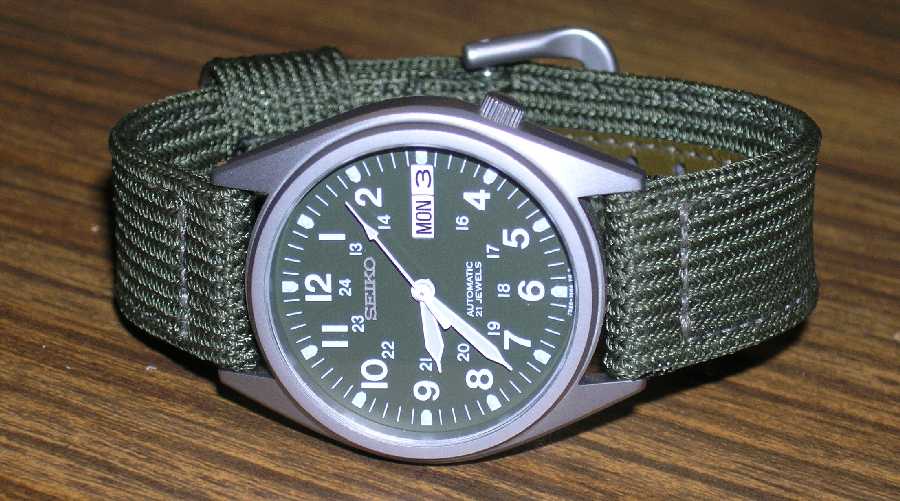Many people are not familiar with the basic parts of a watch. They generally smile and nod when a salesperson rattles off what a watch has. Well, below is simple explanation of what the different parts of a watch are and what varieties there are:
The watch above is a simple, military style watch.
Case: The metal or plastic housing that all the mechanical parts of the watch are contained in.
Bezel: A ring which surrounds the crystal and holds it in place.
Crystal: A transparent piece of material that you look through to read the time. It protects the hands and face of the watch. It can be made of plastic, ordinary glass, mineral glass (stronger than regular glass), or artificial sapphire. Plastic can easily be scratched, but is very shock resistant. Ordinary glass can be scratched and shattered. Mineral glass can be quite tough, depending who makes is. Hardlex is a trade name for it. Sapphire is the most scratch resistant, second only to diamond, but it can shatter when struck.
Strap: The piece of material that wraps around your wrist to hold the watch in place. It can be made of cloth (usually nylon), kevlar, carbon fiber, rubber, and (most commonly) leather. Straps are light and conform to the wrist. They do, however, wear out. Many watches have a bracelet instead. (To elaborate on later.)
Lugs: The strap or bracelet of the watch attaches to the case of the watch here. The most common attachment is spring bars. Spring bars are spring loaded metal pins that are sized to fit between the lugs. There are other ways of attachment, but far less common.
Dial: Also known as the face of the watch. It is usually marked with hour and minute indicators. Some watches have little or no markings, others have many, many markings. This is a personal taste and ease of use issue.
Day/Date Window: Some watches tell more than the time of day. This watch also tells you the day of the week and what date in the month it is. Some watches have month/year indicators as well. Most watches have to manually adjusted on a short month. More expensive watches compensate for short months and even leap years. Again, this is a personal taste issue. I personally use the day/date feature often.
Crown: This small dial on the side of the watch used to be used for hand winding the watch daily. Some watches still do wind, but most are used to just adjust the time. On watches that tell more than the hour/minute, it is used to set the day/date as well. On some watches it is ‘signed’ which just means it has the makers symbol on it. It is purely aesthetic.
Luminous Marker: Some watches have markings that glow after being exposed to light or can glow due to using radioactive materials. It allows the watch to be used in total darkness without having to press a button on the watch.
Some watches use electroluminescent technology to light the watch face (Trade name, Indiglo). This uses power from the battery to make the watch face glow. It is useful in that it makes the watch very easy to read. The downside it that it requires the wearer to press a button and it drains the battery.



